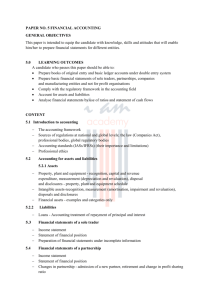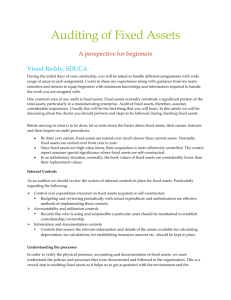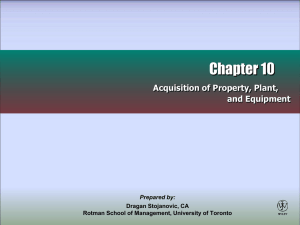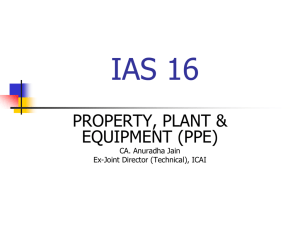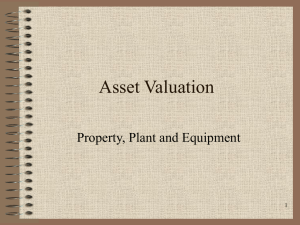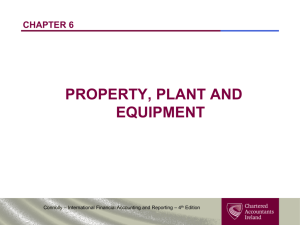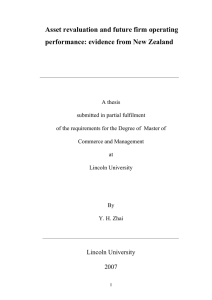PPE - MEFielding
advertisement
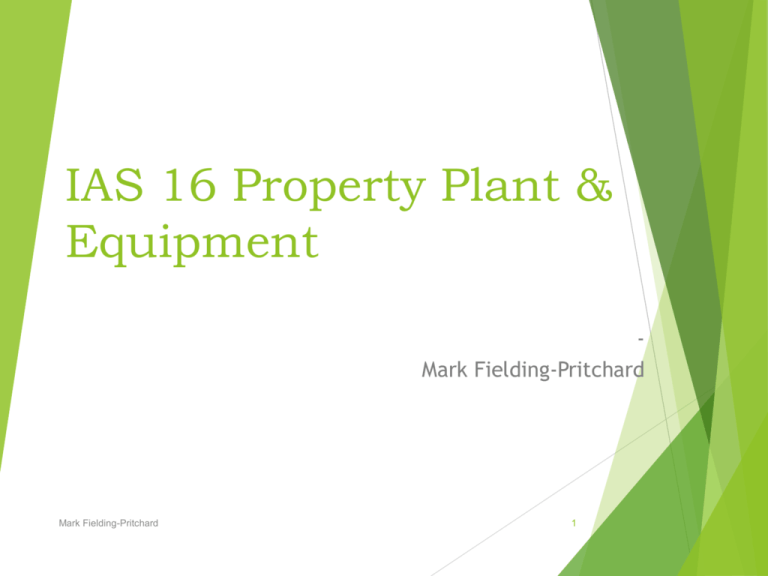
IAS 16 Property Plant & Equipment Mark Fielding-Pritchard Mark Fielding-Pritchard 1 Overview Meaning Scope and objectives Exclusions Definitions Initial recognition Measurement of Cost Subsequent Recognition Subsequent costs Spare parts Mark Fielding-Pritchard 2 Overview Impairment De recognition Revaluation Depreciation Disclosures Decommissioning, restoration and similar liabilities Summary Mark Fielding-Pritchard 3 Meaning Property plant and equipment : Tangible assets Held for : Use in the production or supply of goods or services Rental to others Administrative purposes Assets held by a lessee under finance lease is also included in this category Mark Fielding-Pritchard 4 Scope and Objectives Timing of recognition Determination of carrying amount on initial recognition Subsequent measurement Depreciation Derecognition Disclosures Mark Fielding-Pritchard 5 Exclusions PPT held for sale – IFRS 5 Biological assets related to agricultural activity – IAS 41 Exploration and evaluation assets – IFRS 6 Mineral rights and mineral reserves like oil and natural gas etc Mark Fielding-Pritchard 6 Initial recognition Recognition criteria: Expenses on acquisition or construction of an asset is recognised if the following conditions are met: It is probable that future economic benefits associated with the asset will flow > Transfer of risks and rewards passed to the enterprise Cost of the assets can be reliably measured Mark Fielding-Pritchard 7 Measurement of Cost Initial Measurement @ cost Cost consist of: Purchase price net off discounts and rebates but including import duties and non refundable taxes Direct costs incurred in bringing the asset to the working condition Initial estimated costs of decommissioning, restoration and other obligations Mark Fielding-Pritchard 8 Subsequent Recognition It is done either under cost model or revaluation model Cost Model Asset is carried at cost less accumulated depreciation less accumulated impairment losses Revaluation Model Asset is carried at revalued amount less accumulated depreciation and accumulated impairment losses Revaluation is applied to all assets belonging to same class and revaluation is carried out for the class as whole at regular intervals – Buildings, Plant etc Mark Fielding-Pritchard 9 Subsequent costs They are usually expensed Added to the cost of the asset if: Modification – Extends useful life or increases its capacity Upgrading to achieve substantial improvement in quality New process resulting in reduced operating costs Mark Fielding-Pritchard 10 De recognition An asset is derecognised only on two conditions: 1. On disposal 2. No further economic benefits are expected to be derived from the asset Gains or losses are recognised in the profit and loss account Mark Fielding-Pritchard 11 Revaluation Entire Class of asset should be revalued Rolling basis is permitted Basis of revaluation is “fair value” What constitutes fair value? Mostly market value Increase in the carrying amount on account of revaluation is accounted as revaluation surplus in comprehensive income statement Mark Fielding-Pritchard 12 Revaluation To the extent of the revaluation loss charged off earlier in respect of the same asset could be credited to Income Statement Revaluation loss is charged to Income Statement , however, if there exists any revaluation surplus in respect of the same asset it can be set off to the possible extent Mark Fielding-Pritchard 13 Depreciation Review of residual value at each FY end is to be done Depreciation is taken as a charge even if the fair value is more than depreciable amount No need for depreciation if the residual amount exceeds the carrying amount Depreciation is chargeable if the asset is available for use and ends if the asset is classified as held for sale as per IFRS 5 It does not end due to idleness or even if it is retired from active use Mark Fielding-Pritchard 14 Component model Each part of PPE is to be depreciated separately Eg: Air frame and engine of aircraft For each part cost is allocated, useful life, residual value is determined and depreciation is calculated Mark Fielding-Pritchard 15 Disclosures Some of the items include: Measurement bases Methods of depreciation Useful life or rate of depreciation Reconciliation of carrying amount Revaluation disclosures Impairment Details of idle and retired properties Mark Fielding-Pritchard 16 Decommissioning, restoration and similar liabilities Accounting treatment based on the following: IFRIC 1 covers the changes in existing decommissioning, restoration and simlar liabilities IFRIC 5 right to interest arising from de commissioning, restoration and environmental and rehabilitation funds Mark Fielding-Pritchard 17 Recognition Decommissioning and other related costs are treated as a part of the cost of PPE Provision for liability is created under IAS 37 – Provisions, Contingent liabilities and Contingent Assets Mark Fielding-Pritchard 18



